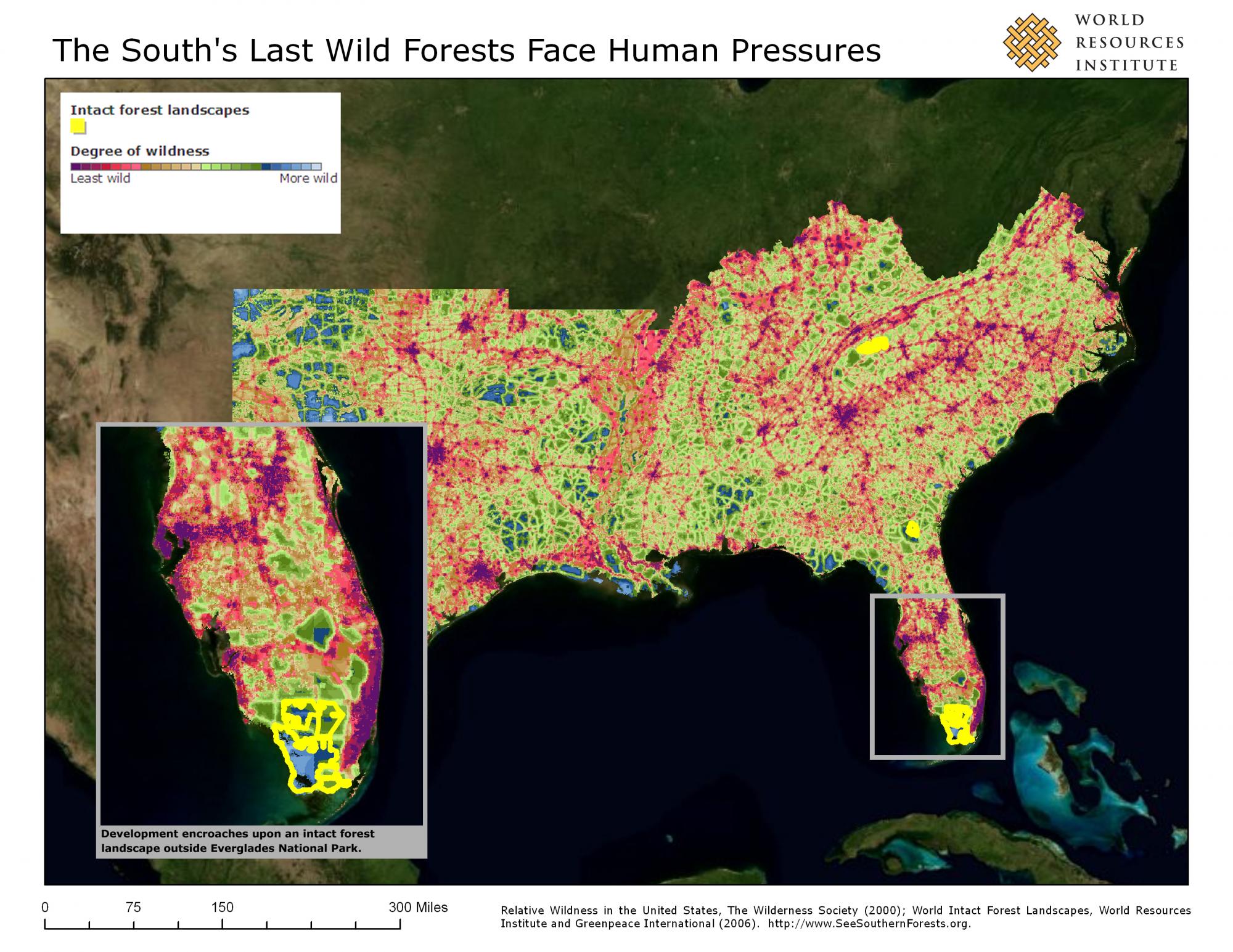Development Encroaches on the Southern United States’ Last “Wild” Areas
As a result of rapid development over the last 40 years, the vast majority of land in the southern U.S. has been in some way impacted by humans. Today, only a small amount of land remains in a relatively natural, or “wild”, state.
In order to visualize the full extent of human activity in the southern U.S., the Wilderness Society produced a map that reflects the relative “wildness” of ecosystems in the region. This map, hosted on www.SeeSouthernForests.org, captures not only important elements of ecological integrity, such as composition, structure and function, but also indicators of human impact, such as population density, distance from roads, and pollution. This map shows that much of the southern U.S. land base is composed primarily of “non-wild” metropolitan centers and surrounding suburban areas, with only a few large sections of “wild” land remaining.
Into the Wild: Intact Forest Landscapes
If major metropolitan centers represent the extreme “non-wild” end of the wildness spectrum, intact forest landscapes would represent the extreme “wild” end. An intact forest landscape (IFL) is considered an unbroken expanse of natural ecosystems within an area of historic forest extent. An IFL shows no signs of recent human alteration, such as logging, mining, or clearing, and is large enough (just under 200 square miles) to maintain native biodiversity.
There are several reasons why intact forest landscapes are important. As a result of minimal human alteration, these landscapes are better able to absorb and recover from disturbances like wildfire and pest and disease outbreaks. Furthermore, they sustain natural levels of wildlife populations and ecosystem diversity, play an important role in climate regulation, and maintain ecological processes and services such as water and air purification, nutrient cycling, carbon sequestration, and erosion and flood control. Conservation of large IFLs is a robust and cost-effective way to protect biodiversity and maintain ecological integrity.
Furthermore, these landscapes provide reference points to help people understand how to better manage other forest landscapes. By taking lessons from IFLs, conservation professionals can design management schemes that preserve or restore significant aspects of natural forest landscapes. For instance, in Alaska’s boreal forest, IFLs showcased natural patterns, structures and processes (e.g. landscape scale fire behavior, amount of dead wood on the ground, etc.) that have been lost in the managed landscape but can be emulated by adapted management. However, as urban centers continue to expand, intact forest landscapes face increasing pressures.
The South’s Last “Wild” Areas
In order to measure and help preserve these areas, the World Resources Institute, Greenpeace and World Intact Forest Landscapes created the Intact Forest Landscapes dataset. This dataset serves as the first global assessment of large undeveloped forest areas based on high spatial resolution satellite imagery. The data uncover that there are only three intact forest landscapes left in the southern U.S., representing less than 1% of total land area in the region. These landscapes include portions of the Great Smoky Mountains National Park; the Okefenokee Swamp; and the forests and wetlands of southwestern Florida, comprised of Big Cypress National Preserve and portions of Everglades National Park.
The Okefenokee Swamp, one of the southern U.S.’ last intact forest landscapes, is a mosaic of wetlands, waterways, and forest. Photo credit: flickr/fkehren
While all of these remaining intact forest landscapes are within protected areas, they are also all bordered by suburban and urban development. This encroachment causes a number of problems. For instance, forest communities within the landscapes are more susceptible to invasive species due to fragmentation from roads. Furthermore, both trees and wildlife may experience negative health effects due to increased levels of air and noise pollution. Lastly, water quality within the landscape may decline due to polluted storm water run-off from surrounding development and from harmful nutrients from surrounding agricultural lands.
These forest landscapes are increasingly at risk of becoming islands of forests within a sea of development if suburban encroachment continues unchecked. Protection and conservation of lands surrounding intact forest landscapes plays a critical role in helping buffer the impacts of development in these last intact landscapes of the southern United States.
Listen to Logan Yonavjak discuss forests in South Florida on NPR (MP3, 3:57, 1.8 Mb)


